Ways to determine an infants caloric needs

Learn how to determine your baby’s caloric needs, including the calories in breast milk and formula, to ensure your infant gets the right nutrition for healthy growth.
Skin diseases in babies are very easy to appear due to changing weather, hormonal factors or irritants from the external environment, maybe even from excessive skin rubbing ... Don't worry too much because these are common diseases, just knowing how to handle them will be all right.
In fact, most infant skin diseases are not life-threatening and can go away on their own after a while with good care. However, parents should also be vigilant to detect and handle promptly so that their children do not have serious skin complications that affect the aesthetics that make children lose confidence in adulthood.
Please join aFamilyToday Health to learn how to recognize, distinguish and handle common skin diseases in newborns so that your baby is always healthy and happy!
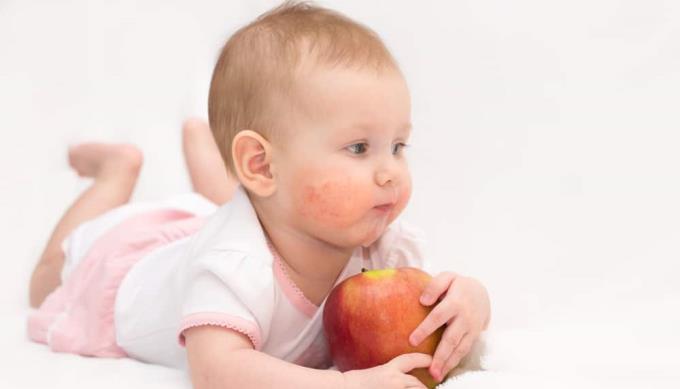
Eczema (also known as strabismus) is a skin disease in babies and young children , especially in babies under 1 year old. Up to now, the cause of the disease has not been determined, but according to experts, there are a few factors that can lead to this condition including: children with atopic allergies, affected by weather, food used by the mother (in case of breast-feeding) or external environmental irritants (pollen, pet hair, dust, mold) ...
• Features of infant eczema : Baby eczema usually appears and then disappears on its own within a few days. This is not a contagious and dangerous disease, but it is very itchy, so it can make the baby uncomfortable, rubbing the eczema with his hands, causing the skin to thicken and hurt. In this case, the eczema will take a long time to heal and may leave scarring.
Many cases of eczema often come back again and again many times, but most will recover completely by the time your baby is 2 years old.
• Recognizing infant eczema : Eczema (also known as atopic dermatitis or atopic dermatitis) is redness and dryness, thickening, scaly, or shows tiny red dots.
The eczema is usually on the cheeks, on the face, or spreading to the chest, arms, legs, or any other part. Initially, these were just red spots, then gradually turn to red tiny blisters that cause cracking, crusting, and peeling. Eczema in children over the age of one usually shows up in the folds of the elbows, knees, wrists, and ankles.
• How to treat eczema : When your baby has eczema, you should:
- Ensure the child's body is always dry, clean, and sweat less. Accordingly, mothers should bathe the baby with gentle soaps, absolutely do not use those containing scent chemicals and foam.
- Wash baby's blankets, clothes, towels with safe, mild and non-irritating soaps. Avoid leaving your dog near cats or dogs or moving to dusty areas.
- Pay attention to foods and environmental factors that can cause allergies such as eggs, seafood, fermented foods, tomatoes ...
Use baby moisturizer .
- If after a while the eczema does not go away on its own or gets worse, the baby becomes uncomfortable and fussy, it may be necessary to apply steroid creams (eg hydrcortison or stronger creams).
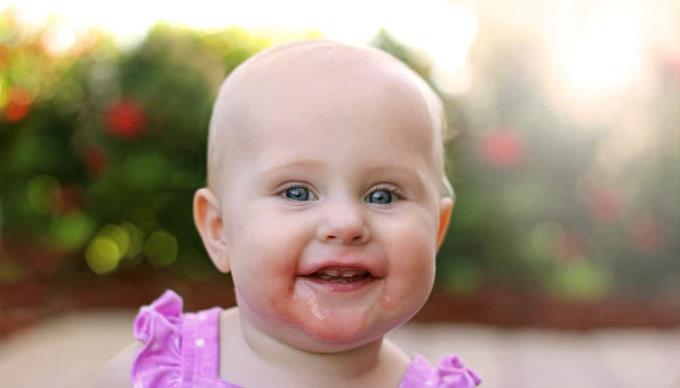
This is a skin disease in an infant that occurs when the baby's skin is in constant contact with saliva or milk.
• Features of a red rash around the mouth: A rash around the mouth related to saliva. The disease is caused by causes such as reflux of the baby, milk flowing out while breastfeeding or bottle feeding, drooling when teething (4-5 months) or using a pacifier for too long.
The red spots around the mouth will go away on their own if the baby is carefully cared for and cleansed.
• Identify a baby's red rash around the mouth: A red rash around the mouth is a tiny red rash on the cheeks around the baby's mouth and chin. The redness around the mouth is quite similar to eczema, but the most noticeable difference in these two diseases is where the rash appears. Eczema, in addition to the cheeks also appear on the head, chest, arms ...
The rashes around the mouth usually only occur in areas of the skin frequently exposed to the child's saliva, such as around the mouth or chin, chest.
• How to deal with a red rash around the mouth: When a baby has a red rash around the mouth, you should carefully take care of this area.
- After your baby is suckling or has a spurt and drooling, you should use a towel or soft cotton to dry around the mouth, chin, chest, neck and apply moisturizer. You can also use bibs to prevent the rash from spreading to the chest.
- Avoid washing too many times, making baby's skin dry and hurt
- Pat your baby's head up and burp to avoid reflux after breastfeeding and limit breastfeeding for too long. Every time the baby sleeps, the mother should put a towel to absorb the drool.
- Apply ointment to avoid skin inflammation for your baby.
You should be careful to distinguish a rash from other infant skin conditions such as oral thrush or foot-and-mouth disease when your baby has a rash around the mouth.
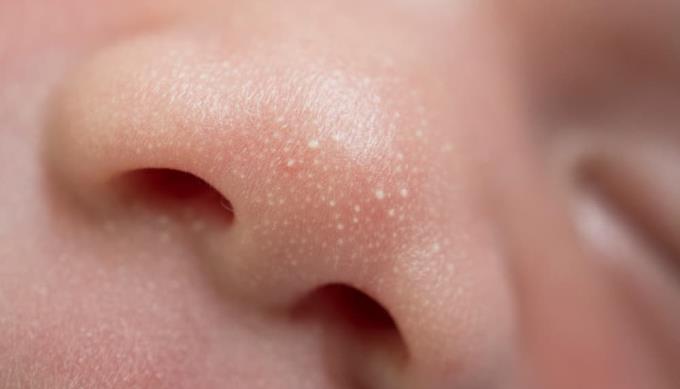
Milia (milia also known as milia, acne) is one of the most common skin diseases in babies. In the early stages of life, about 40% of babies develop milia . The main reason is that the action of hormones causes sebum stagnation in the places where there are many sebaceous glands on the skin, leading to the formation of milia in these locations.
• Features of milia : Milia can start to appear from the first days or weeks after the baby is born. The acne will become more raised or red if your baby's temperature increases or if the skin gets irritated.
• Identify infant milia : Milia usually occurs mainly on the cheeks, but sometimes occurs on the nose, forehead, chin and even on a newborn's back. Acne takes the form of tiny white pimples like acne, may be surrounded by red skin.
• How to treat a baby with milia: Milia is not contagious or affects your baby's health, but it can make your baby uncomfortable.
With good care and hygiene, milia usually clears up on its own in a few weeks to 1-2 months.
You do not need to worry too much, but pay attention to nutrition and hygiene for your baby according to the following notes:
- Avoid washing too much or rubbing on the milky area because it can irritate the skin or cause skin scratches or damage. Regularly change clothes, diapers to keep the baby dry. In the case of milia growing in the armpit or groin, you can use baby-safe baby powder.
- Use gentle shower gel, neutral pH to clean your baby in the morning and at night, then pat dry with a clean cotton towel.
- Use blankets, mattresses, baby's clothes made of dry, air-friendly and non-irritating materials
- Do not let the room get too hot or overdress baby. Absolutely avoid rubbing, squeezing or trying to squeeze pimples will make baby's skin more damaged.
If you are breastfeeding, you should consider limiting foods that can cause allergies such as eggs, soybeans, peanuts, seafood, spicy and hot foods.
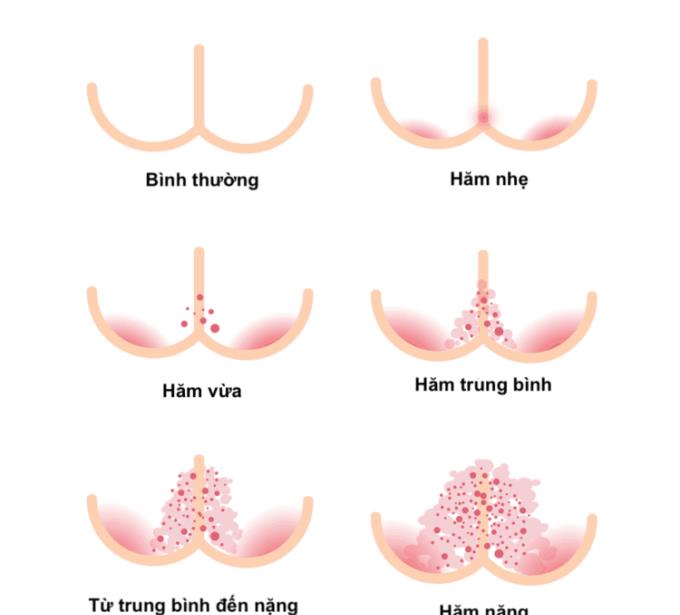
Diaper rash is common in children 3–15 months of age, but also in infants under 3 months of age. The cause of diaper rash is that the skin is rubbed or not ventilated, but it is wet or sweaty, causing the skin's urinary system to become clogged, causing skin irritation. Stagnation of urine, feces, or certain irritating chemicals can also cause diaper rash.
• Recognize when your baby has diaper rash: Diaper rash is a common skin disease in babies and young children. The disease often appears on the skin of the baby who often wears diapers or diapers. Initially, your baby may only be red, a mild rash and appear a few small spots, but when worse, it can cause irritation, cracked and scratched skin.
• How to treat a baby with diaper rash: If your baby has only mild diaper rash, you don't need to worry too much because a child with mild diaper rash can go away on its own in 3–5 days if parents properly clean and keep the diaper rash. the diaper area is clean and dry.
If diaper rash gets worse, causing the diaper rash to have sores, pimples or cracks ... and the child is tired and uncomfortable, he or she should see a dermatologist.
• Baby diaper rash prevention: To prevent diaper rash in babies, you should always keep the diaper contact area of the baby's diaper dry, clean and free from scratches by following the following precautions:
Change diapers as soon as they are wet, dirty. Choose diapers that are soft, dry, and skin-friendly.
- After changing diapers, you should clean your baby's genitals gently, clean then dry this area and then put on a new diaper. During the process, avoid rubbing too hard, which will make your baby hurt and scratch the skin.
- Don't wear too tight diapers or pants. In addition, do not apply too much powder because it will easily clog the pores and prevent moisture loss of the skin.
- Each time you change diapers, you can apply a diaper rash cream (the one suitable for baby's skin).
- Regularly monitor the skin in contact with the diaper each time to change the baby to take appropriate corrective measures
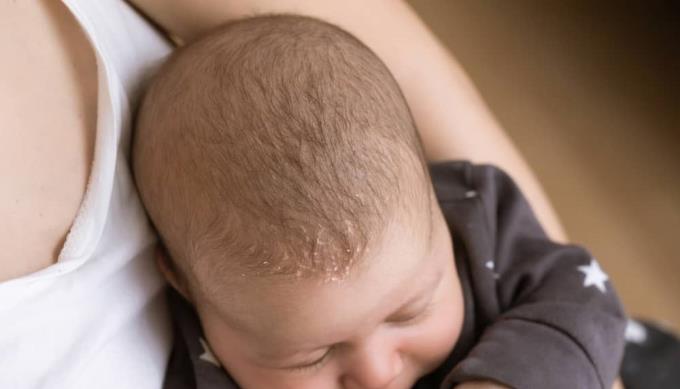
Seborrheic dermatitis is a skin disease in infants 0–3 months of age that resolves on its own in a short time, however in some cases it persists until the baby is 1 year old or even up to 4 years old. According to statistics, about 10% of babies suffer from seborrheic dermatitis. According to scientists, seborrheic dermatitis in babies can be caused by hormones that increase sebum secretion in hair follicles or by Malassezia fungus.
• Distinguishing seborrheic dermatitis and eczema: Seborrheic dermatitis looks quite similar to eczema but eczema is often itchy and uncomfortable and seborrheic dermatitis does not. Eczema also often occurs on the cheeks, seborrheic dermatitis usually appears on the scalp and oily areas such as behind the ears, under the eyebrows ...
• Recognize seborrheic dermatitis : Seborrheic dermatitis usually appears on the scalp and forms a yellow sebum or flaky patches like dandruff on a child's scalp. In addition to the scalp, seborrheic dermatitis can also be found behind the ears, sometimes in the skin under the eyebrows or in the nose, armpits or groin. Scales may appear dry or greasy and are usually white or yellow in color.
• How to treat seborrheic dermatitis : Seborrheic dermatitis is not contagious, nor is it a sign of illness because you are not taking care of and cleaning your baby well. These flakes or flakes may go away on their own without medical treatment.
When your child has seborrheic dermatitis, you should wash your baby's hair regularly with baby shampoo, gently rub your baby's scalp with your hands or use a soft brush to brush your baby's scalp to gradually flake off. Note when choosing to buy shampoo, mothers should carefully look at the ingredients, avoid choosing one containing salicylic acid that is easy to cause irritation and poisoning in children.
Alternatively, you can use a soft bristle brush to gently brush every day after shampooing. This will help get rid of scalp flakes. In the event that your baby's scalp is oozing, yellowing, you should bring your baby to the doctor for examination because this may be a condition where the baby has superinfection with bacteria and requires antibiotics to treat.
You should not rub vigorously or use shampoo to treat dandruff to avoid damaging the baby's scalp and seek immediate medical attention if the disease does not improve.

Although infant skin diseases are not too dangerous, they can be itchy and uncomfortable, so you should pay attention to care for your baby to be more comfortable. Your baby's skin will quickly smooth again if you keep the hygiene and skin care properly for your baby.
Learn how to determine your baby’s caloric needs, including the calories in breast milk and formula, to ensure your infant gets the right nutrition for healthy growth.
Discover the top 5 smartest dog breeds in the world, including Border Collie, Poodle, German Shepherd, Golden Retriever, and Doberman Pinscher. Learn about their unique traits and why they are considered the most intelligent dogs.
Discover 7 nutritious and delicious ways to cook egg porridge for babies, including recipes with cheese, pumpkin, tomato, and more. Learn how to prepare baby-friendly egg porridge with our expert tips.
After a series of medical measures they obtained a complete human vascular system profile.
Watermelon is one of the fruits that many people love, not only cheap but also delicious, nutritious and refreshing in the summer. To get delicious watermelon pieces, show off your housewives, your artistic talents to cut beautiful pieces of watermelon.
aFamilyToday Health - The digestive system and body in each baby is different. Parents need to recognize notes to deal with when babies have a food allergy!
Babies need many factors for perfect development. aFamilyToday Health shares with parents things to keep in mind when babies are 8 weeks old so that parents can take care of their babies the best!
Babies need many factors for perfect development. aFamilyToday Health shares with parents things to keep in mind when babies are 18 weeks so that parents can take care of their babies the best!
Babies need many factors for perfect development. aFamilyToday Health shares with parents things to keep in mind when babies are 28 weeks old so that parents can take care of their babies the best!
Babies need many factors for perfect development. aFamilyToday Health shares with parents things to keep in mind when babies are 32 weeks old so that parents can take care of their babies the best!








